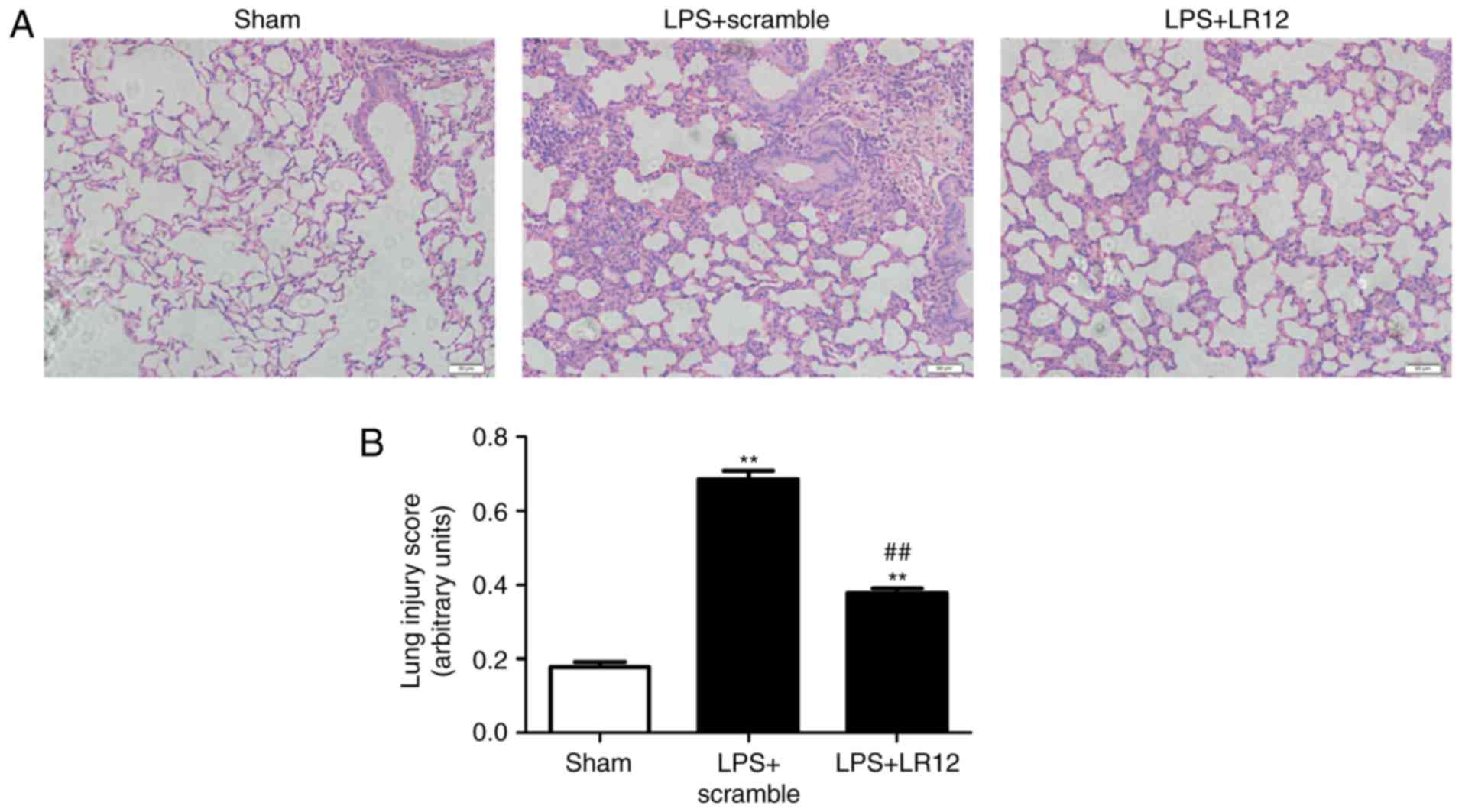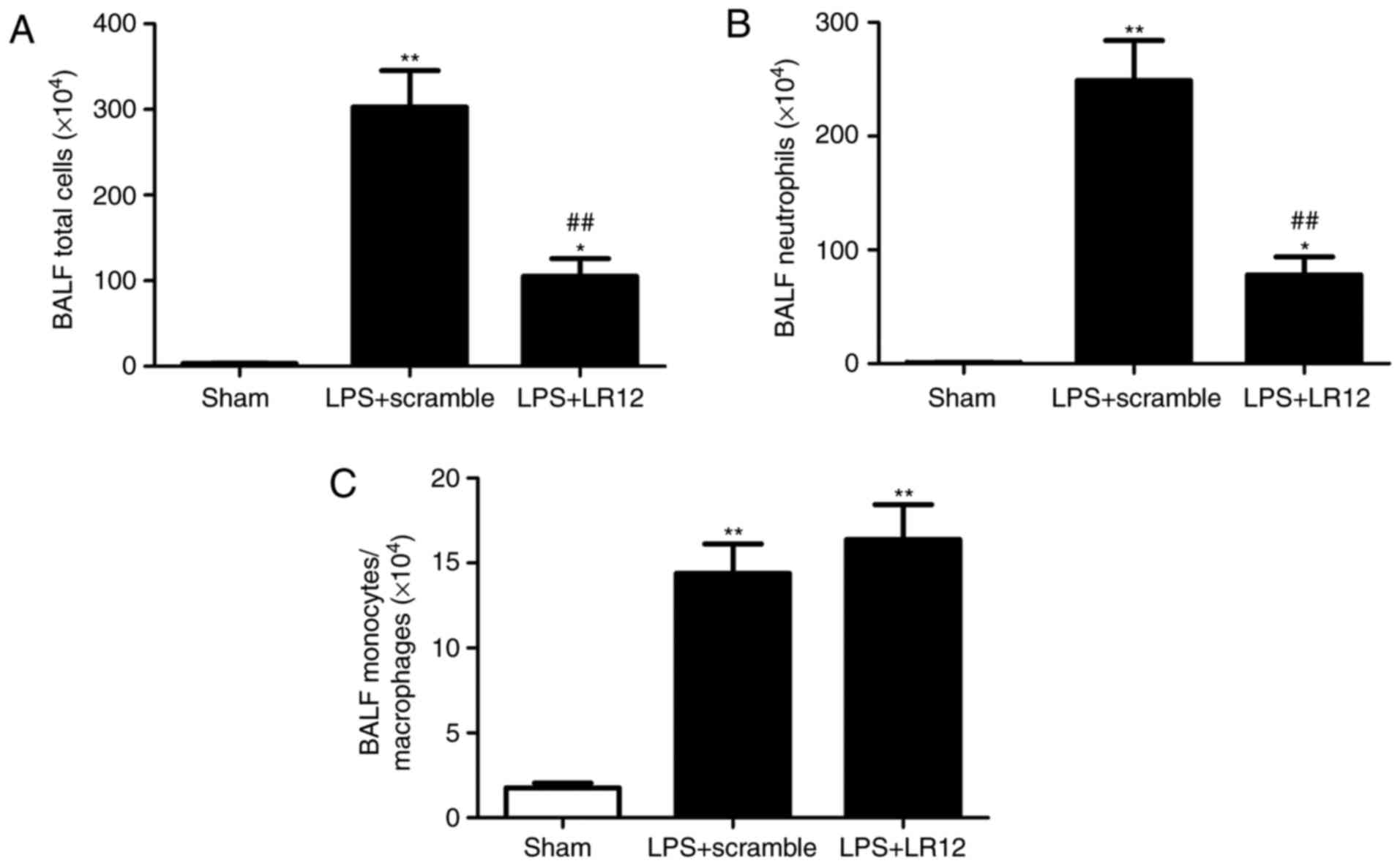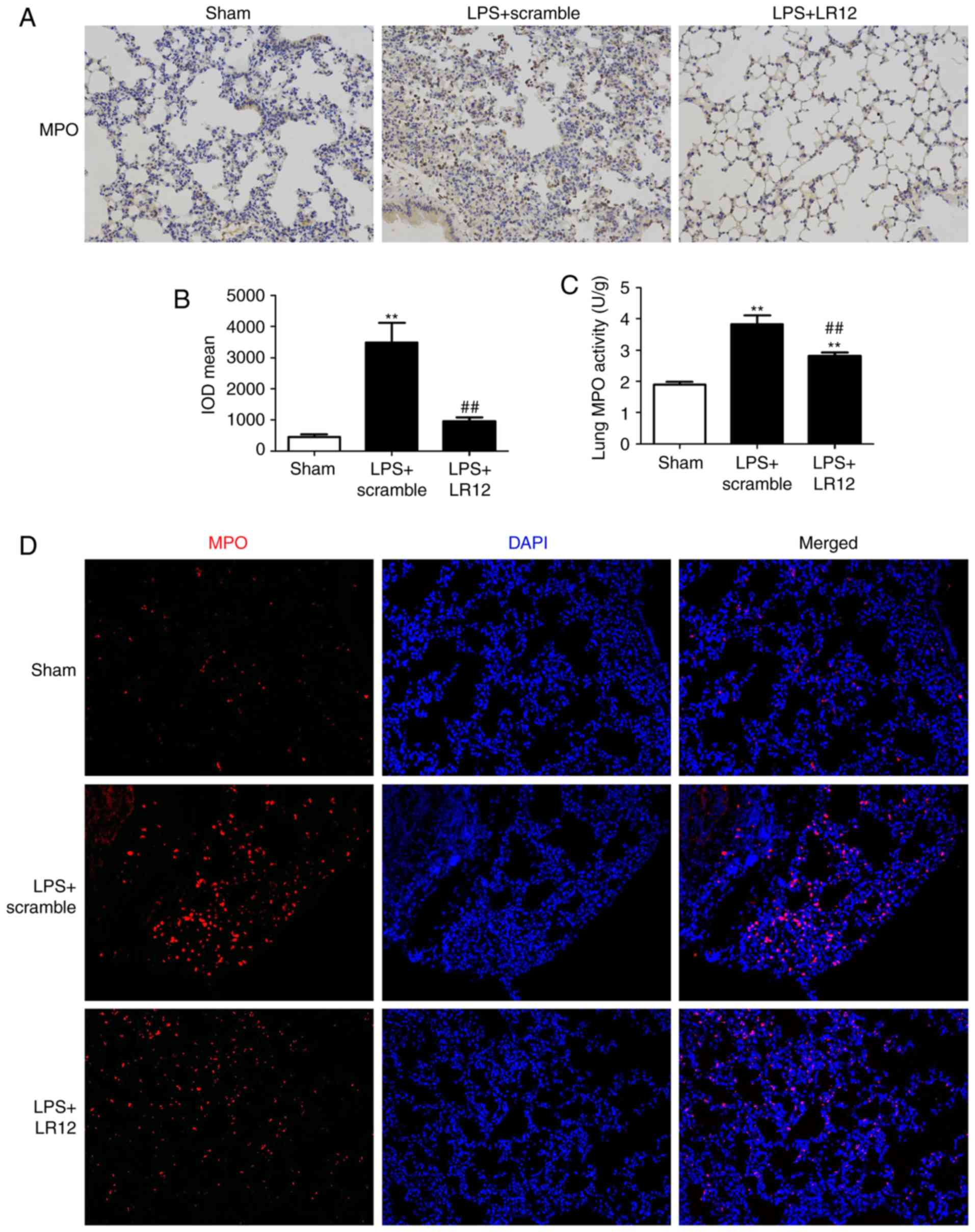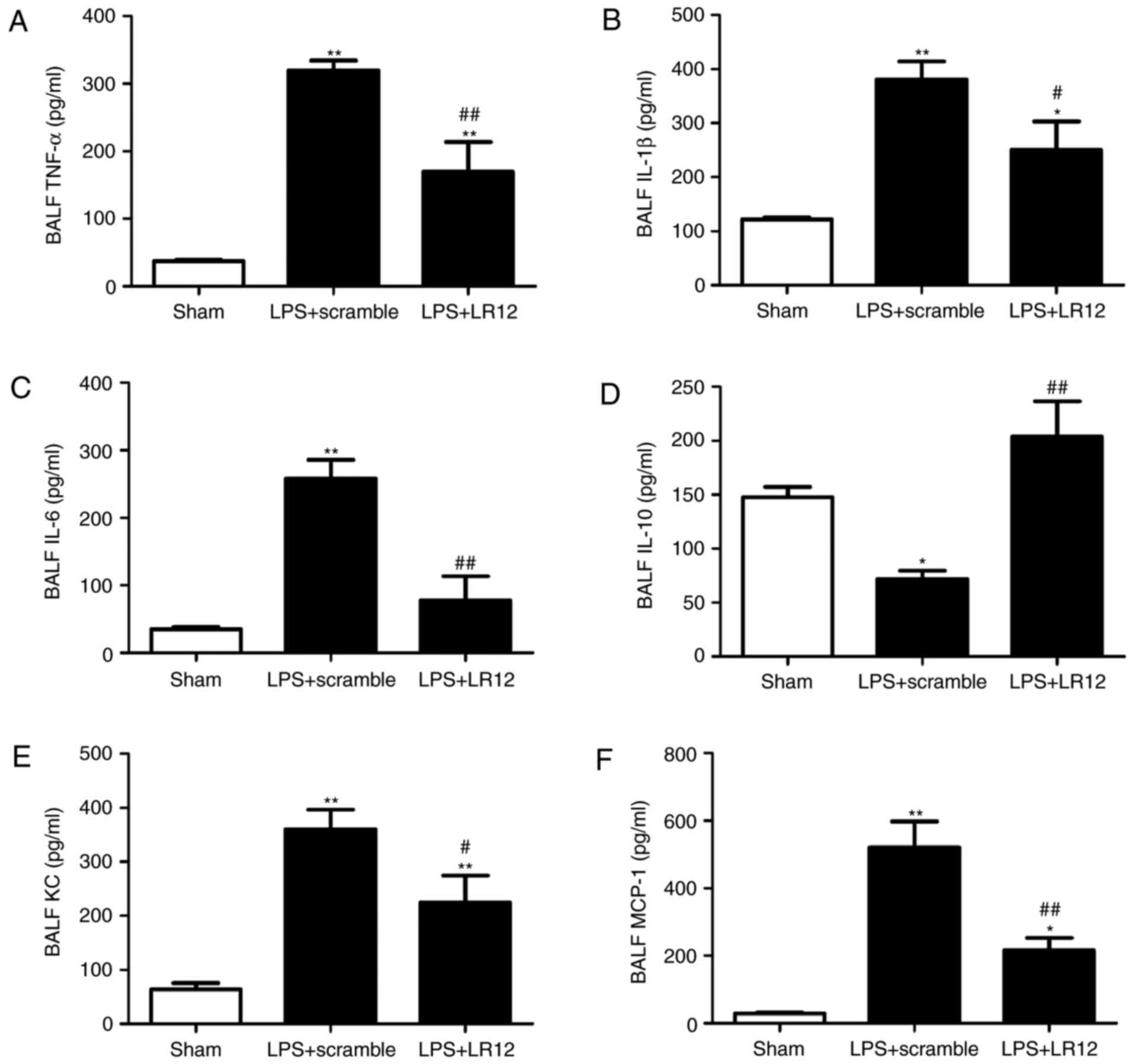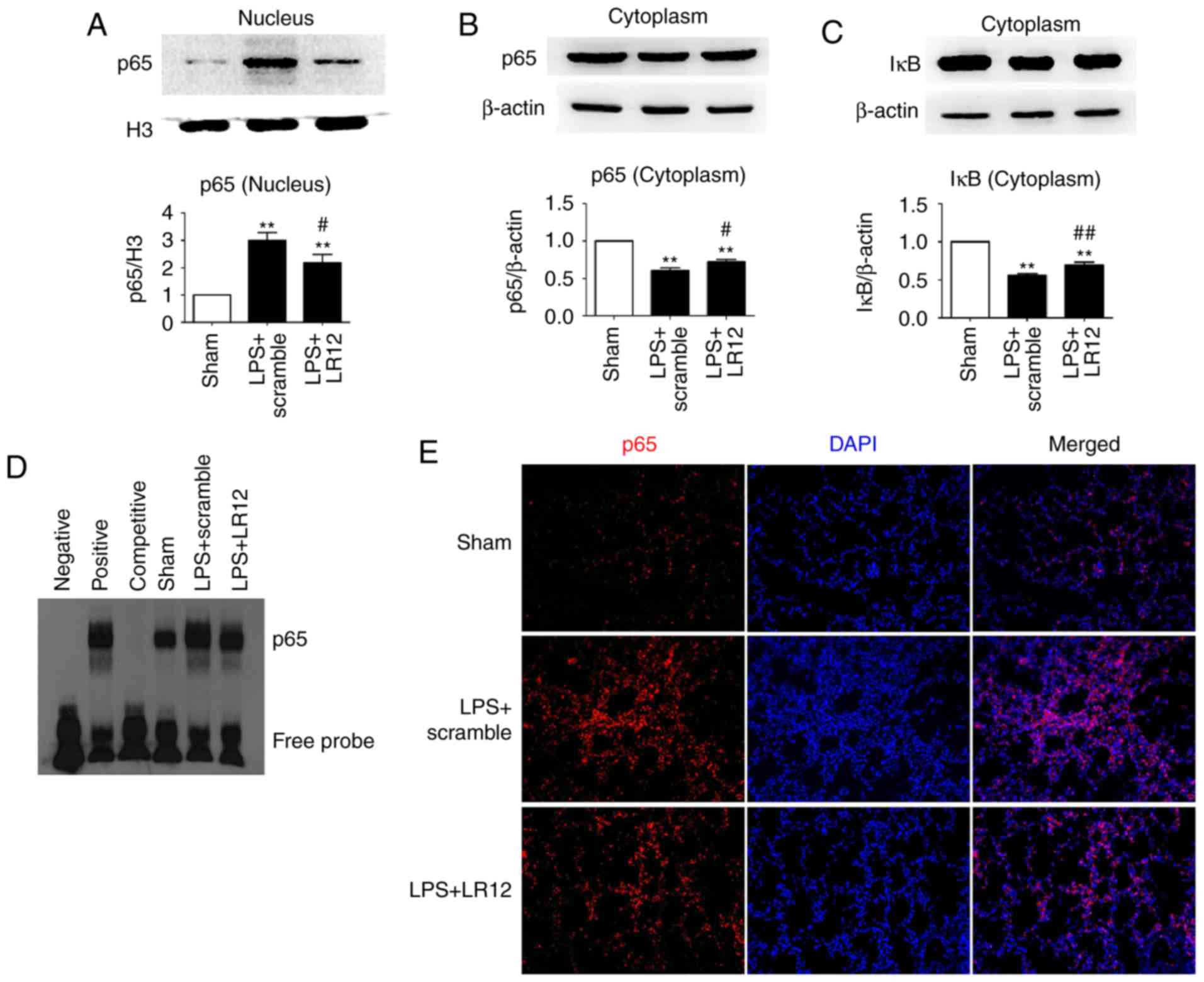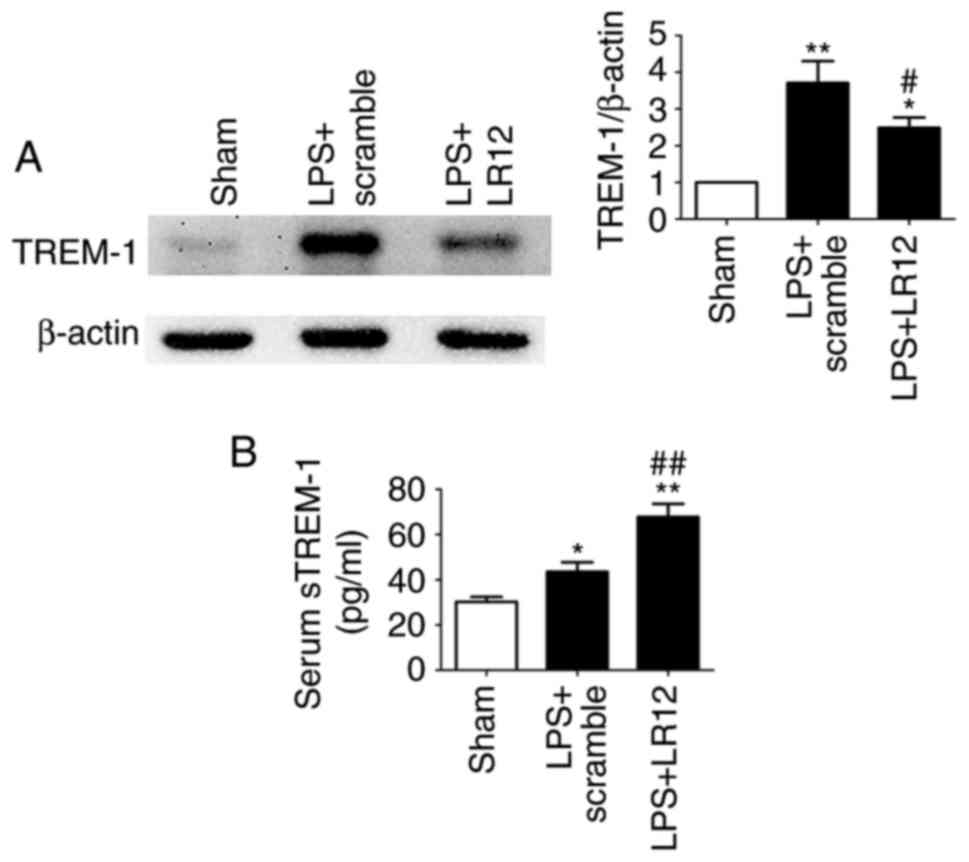Expression level of 12-amino acid triggering receptor on myeloid cells-like transcript 1 derived peptide alleviates lipopolysaccharide-induced acute lung injury in mice
- Authors:
- Published online on: January 30, 2018 https://doi.org/10.3892/ijmm.2018.3443
- Pages: 2159-2168
Abstract
Introduction
Acute lung injury (ALI) and acute respiratory distress syndrome (ARDS) are life-threatening conditions, the clinical manifestations of which are refractory hypoxemia and progressive dyspnea (1). Current studies indicate that the release of proinflammatory cytokines and chemokines are key factors in ALI. Inflammation is a protective defense system that acts against the invasion of pathogens (2,3); however, the excessive inflammation induces tissue and organ injury (3). Excessive inflammation induced by bacterial infection performs a major role in the progression of ALI, although the exact mechanisms remain unclear (4). Blocking the progression of inflammatory cascades has been demonstrated as a valid method of mitigating ALI (5,6), indicating that inflammatory blocking agents may be used to prevent and treat ALI.
In 2000, triggering receptor expressed on myeloid cells-1 (TREM-1) was first reported by Bouchon et al (7). TREM-1, a member of the immunoglobulin superfamily, is expressed on monocytes/macrophages and neutrophils (7,8). TREM-1 is deemed to be an amplifier of inflammation (8). TREM-1 triggers neutrophil degranulation and oxidative burst (7,9–11), which is one of the most upregulated signaling pathways in inflammation (12). Engagement of TREM-1 with agonist monoclonal antibodies increases the secretion of tumor necrosis factor (TNF)-α, keratinocyte chemokine (KC) and monocyte chemoattractant protein-1 (MCP-1), and inhibits the release of interleukin (IL)-10 by monocytes (13–15). Studies have demonstrated that TREM-1 is a necessary regulator of immunity and a potential therapeutic target in septic shock (16). Blocking TREM-1 signaling using a fusion protein or a short inhibitory peptide shows a protective effect in bacterial sepsis caused by live Escherichia coli and Pseudomonas aeruginosa, and in lipopolysaccharide (LPS)-induced shock, as well as in cecal ligation and puncture models of sepsis (9,16–19). In addition, TREM-1 deficiency reduced local release of cytokines and chemokines, and delayed the influx of neutrophils (20). Furthermore, TREM-1 deficiency decreased the transepithelial migration of neutrophils into the lung (21). In other acute or chronic inflammatory diseases, the protective effects of blocking TREM-1 have been confirmed (22–25). Recently, Liu's group (26) reported the regulation of NLR family pyrin domain containing 3 (NLRP3) inflammasome activation by TREM-1, which relieves LPS-induced ALI and improves survival rate via pretreatment methods. Hence, the role of TREM-1 in LPS-induced ALI requires further investigation.
Crystallographic studies reveal that the structure between TREM-like transcript-1 (TLT-1) and TREM-1 are similar, which indicates the existence of interactions between TLT-1 and TREM-1 (27). Previous studies demonstrate that TLT-1 and LR12 behave like natural TREM-1 inhibitors, which exhibit anti-inflammatory properties by inhibiting TREM-1 signaling (28,29). It has been identified that LR12 exerts protective effects in hypodynamic septic shock in pigs, and mediates inflammatory injury and cardiac remodeling following myocardial infarction in mice (30,31). Furthermore, LR12 weakens endotoxin-associated clinical and biological alterations, and no obvious side effects were identified in nonhuman primates (29).
Hence, by using an LPS-induced ALI model in C57BL/6 mice, the roles and potential underlying mechanisms of TREM-1 in LPS-induced ALI were investigated in the present study.
Materials and methods
Animals
All animal experiments were approved by the Animal Care and Use Committee of Tongji Medical College of Huazhong University of Science and Technology (Wuhan, China; certification no. 2015 S621). Six to eight-week old male C57BL/6 mice (weight, 20–25 g) were purchased from the animal experimental center of Wuhan University (Wuhan, China). Mice were housed (4 mice/cage) in a specific-pathogen-free room at a temperature of 22–24°C, humidity of 60–65% and under a 12-h light/dark cycle. The animals were allowed free access to standard laboratory chow and water, and acclimatized to the environment for 5 days before the experiments.
Introduction of LR12 and LR12 scramble
LR12 is a 12-amino acid peptide, which is derived from TLT-1 (LQEEDAGEYGCM), and the placebo, LR12 scramble (a COOH-terminal amidated peptide) is the corresponding scramble peptide (YQMGELCAGEED). These peptides were synthesized by Bioyeargene Biosciences Co., Ltd. (Wuhan, China). The peptides were homogeneous and with a purity of >99%, which was confirmed by mass spectrometry and analytic reversed-phase high-performance liquid chromatography. These peptides were free of endotoxin.
Experimental procedures
All the mice were divided randomly into three groups as follows: Sham, LPS + scramble and LPS + LR12 (n=5 per group). The preliminary experiment identified that there was no difference in ALI between model groups treated with normal saline (NS) and LR12 scramble (data not shown). The mice were anaesthetized intraperitoneally with 90 mg/kg of 1% sodium pentobarbital (Sigma-Aldrich; Merck KGaA, Darmstadt, Germany) prior to surgery. Following successful endotracheal intubation, mice were instilled with LPS (Escherichia coli serotype O55:B5; Sigma-Aldrich, Merck KGaA) at a dosage of 3 mg/kg (LPS + scramble group and LPS + LR12 group) or NS (1.5 ml/kg; sham group) (2). LR12 (5 mg/kg LPS + LR12 group), LR12 scramble (5 mg/kg; LPS + scramble group) or NS (5 ml/kg; sham group) was administrated intraperitoneally 30 min after intratracheal instillation with LPS or NS (30). The treatment was repeated every 3 h three times.
Twenty-four hours after intratracheal instillation with LPS or NS, mice were anesthetized with an overdose of sodium pentobarbital and 1 ml blood samples were collected from the eyeball. The blood was centrifuged at 1,000 × g for 10 min at room temperature and the supernatant was stored at −80°C for further experiments. The right lung was clamped at the level of the main stem bronchus. Lung tissue samples were excised and rinsed with cold phosphate-buffered saline to obtain the lung wet/dry (W/D) weight ratio and for histologic analysis, or frozen in liquid nitrogen and stored at −80°C for further investigation.
Histological analysis of lung tissue samples
The right lower lobes of the lungs were embedded in paraffin wax and the sections (~6-mm thick) were stained with hematoxylin for 10 min at room temperature and then with eosin for 3 min at room temperature. The lung injury scores were evaluated by an investigator who was blinded to the experimental design according to the published criteria (Table I): Score=(20xA+14xB+7xC+7xD+2xE)/(number of fields x100) (32).
Differential leukocyte counts and pulmonary edema
Bronchoalveolar lavage fluid (BALF) was collected by bronchoalveolar lavaging with 0.4 ml NS from the left lung three times. The BALF was spun at 4°C for 10 min at 250 × g. Supernatant was collected and stored at −80°C for protein and cytokine detection. The cell aggregate underwent differential leukocyte counting. Total BALF cells were measured using a hematocytometer and stained with Giemsa stain solution for 30 min at room temperature. A total of 200 cells/slide were randomly selected to calculate the percentage of neutrophils and monocytes/macrophages in the sample under the microscope.
Pulmonary W/D weight ratio and the BALF protein concentrations were detected for the assessment of pulmonary edema. For the W/D weight ratio, the right-middle lobes were weighed as soon as they were removed. The lobe samples were placed in an oven and weighted again 24 h later when they were dried. BALF protein concentration was estimated using a Bicinchoninic acid Protein Assay kit (cat. no. 23227; Thermo Fisher Scientific, Inc., Waltham, MA, USA) and the procedure was performed according to the manufacturer's instructions.
Pulmonary MPO activity
Lung tissue samples were homogenized with isotonic sodium chloride to detect the MPO activity. Lung tissue MPO activity was measured using the MPO kits (cat. no. A044; Nanjing Jiancheng Bioengineering Institute, Nanjing, China). Detection was conducted according to the manufacturer's instructions.
Immunohistochemistry
Following deparaffinization and repair, the sections were incubated in 3% hydrogen peroxide for 30 min at room temperature and blocked using 5% goat serum albumin (cat. no. SL038; Beijing Solarbio Science and Technology Co., Ltd., Beijing, China) for 20 min at room temperature. The sections were incubated with MPO antibody (cat. no. ab208670; 1:100; Abcam, Cambridge, MA, USA) overnight at 4°C. Then the secondary antibody (cat. no. A25112; 1:100; Abbkine Scientific Co., Ltd., Wuhan, China) was added to the sections for 50 min at 4°C. The sections were stained with 3,3′-diaminobenzidine and re-dyed with hematoxylin at room temperature. The integrated optical density was analyzed using the Image-pro Plus 6.0 software (Media Cybernetics, Inc., Rockville, MD, USA).
Immunofluorescence
Following deparaffinization, microwave-treated antigen retrieval was conducted in sodium citrate solution. Subsequently, nonspecific binding was blocked using goat serum for 30 min. The sections were incubated with the MPO antibody (1:100) or p65 antibody (cat. no. ab16502; 1:100; Abcam) overnight at 4°C. The secondary antibody was added for 2 h after washing three times with PBS. The coverslips were counterstained at room temperature with 4′,6-diamidino-2-phenylindole for 5 min and images were acquired using a fluorescence microscope in a dark room.
ELISA
The expression levels of TNF-α, IL-1β, IL-6, IL-10 and KC in BALF were detected by using ELISA kits (cat. nos. EMC102a, EMC001b, EMC004, EMC005 and EMC104, respectively; NeoBioscience Technology Co., Shanghai, China). The expression levels of MCP-1 in BALF were evaluated using the ELISA kit (cat. no. ELM-MCP1-001; RayBiotech, Inc., Norcross, GA, USA) and sTREM-1 was analyzed with an ELISA kit (cat. no. CSB-E13848m; Cusabio Biotech Co., Ltd., Hubei, China). The intensity of the color was measured at 450 nm using a microplate reader (Bio-Rad Laboratories, Inc., Hercules, CA, USA) and the procedure was performed according to the manufacturer's instructions.
Western blotting
Protein was extracted from the lung tissue sample homogenates according to the manual provided by the Protein Extraction kit (cat. no. KGP150; Nanjing KeyGen Biotech Co., Ltd., Nanjing, China). The nuclear protein and cytosolic protein were separated during the procedure. Proteins were separated by electrophoresis on 10% polyacrylamide SDS gels and transferred to a polyvinylidene difluoride membrane by wet transfer (200 mA, 1 h). The membranes were blocked with 5% non-fat milk for 1 h, and incubated with p65 (cat. no. ab32536; 1:2,000), inhibitor of NF-κB (IκB) (cat. no. ab32518; 1:1,000), TREM-1(cat. no. ab104413; 1:500), β-actin (cat. no. ab8226; 1:1,000) (all Abcam) and histone H3 (cat. no. 4243; 1:500; Cell Signaling Technology, Inc., Danvers, MA, USA) individually, overnight at 4°C. After washing three times with TBS containing 0.05% Tween-20, horse radish peroxidase-conjugated goat anti-rabbit Immunoglobulin G (IgG) antibodies (cat. no. SA00001-2; 1:2,000) or anti-mouse IgG antibodies (cat. no. SA00001-1; 1:2,000) (both Proteintech Group, Inc., Wuhan, China) was added at room temperature for 1 h. Chemiluminescent detection was performed using Western Lighting Chemiluminescence Reagent (Beyotime Institute of Biotechnology, Shanghai, China). Images were scanned using a UVP imaging system and analyzed using ImageJ software (version 1.45s; National Institutes of Health, Bethesda, MD, USA).
Electrophoretic mobility shift assay (EMSA) for p65. The protein extract was prepared using a protein extraction kit (cat. no. KGP150; Nanjing KeyGen Biotech Co., Ltd.). Each sample contained an equivalent magnitude of nuclear extract protein (10 µg), and the 50-fmol biotin-labeled, double-strand probe was incubated for 15 min at room temperature. The oligonucleotide probe sequence of the p65 binding site was 5′-AGT TGA GGG GAC TTT CCA GGC-3′. The DNA-protein complexes were electrophoresed on a 6.5% nondenaturing polyacrylamide gel and electrotransferred for detection.
Statistical analysis
All data are presented as the mean ± standard error of the mean. GraphPad Prism version 5.0 (GraphPad Software, Inc., La Jolla, CA, USA) was used to analyze the results. Following testing for their normal distribution (using the Kolmogorov-Smirnov test), the significance of the difference between the groups was tested by one-way ANOVA, and pairwise comparisons were performed between groups using the Newman-Keuls method. P<0.05 was considered to indicate a statistically significant difference.
Results
LR12 attenuates pathological changes and lung injury scores in mice with LPS-induced ALI
The pulmonary construction was normal and, under light microscopy, fewer macrophages were observed in the alveolar space in the sham group (Fig. 1A). LPS treatment significantly increased the damage and hemorrhaging in the lung tissue samples. The thickness of the alveolar septal interstitium and neutrophil infiltration were significantly increased following treatment with LPS (Fig. 1A). LR12 significantly alleviated lung tissue injury when compared with the LPS + scramble group (Fig. 1A). Furthermore, the lung injury scores were assessed in parallel with the pathohistological changes (Fig. 1B).
LR12 attenuates the changes of lung tissue permeability in mice with LPS-induced ALI
The lung tissue sample W/D weight ratio and BALF protein concentration reflect the changes in lung tissue permeability. Compared with the sham group, the lung tissue sample W/D weight ratio and BALF protein concentration were significantly elevated in the LPS + scramble group, which indicated an obvious disruption in the microvascular permeability of the lung tissues. The lung tissue sample W/D weight ratio and BALF protein concentration in the LPS + LR12 group were significantly decreased compared with that in the LPS + scramble group (Fig. 2).
LR12 suppresses the variation of lung leukocyte recruitment in mice with LPS-induced ALI
Following LPS treatment, the BALF cytology changed markedly in the alveoli. Compared with that in the sham group, the numbers of total cells, macrophages and neutrophils were significantly increased in the LPS + scramble group (Fig. 3A–C).
The number of total cells and neutrophils, but not macrophages in the BALF were significantly decreased following treatment with LR12 (Fig. 3A–C).
LR12 suppresses neutrophil infiltration of lung tissues in mice with LPS-induced ALI
Immunohistochemical staining indicated that LPS treatment significantly increased the MPO-positive cells in the lung tissue samples (Fig. 4A and B). Treatment with LR12 significantly attenuated the LPS-induced significant increase of the MPO-positive cells in the lung tissue samples when compared with that in the LPS + scramble group (Fig. 4A and B). MPO activity of the lung tissue samples is an important indicator of neutrophil infiltration. The MPO activity of lung tissue samples from the LPS + LR12 group was significantly decreased when compared with that in the LPS + scramble group (Fig. 4C). The immunofluorescence staining for MPO confirmed the results (Fig. 4D).
LR12 suppresses the expression of proinflammatory cytokines and promotes the expression of anti-inflammatory cytokines in mice with LPS-induced ALI
Inflammatory cytokines are important in neutrophil recruitment and propagation of the inflammatory response. These particular inflammatory cytokines were detected in BALF using ELISA in order to investigate their effects. Compared with that in the sham group, the expression levels of proinflammatory cytokines (TNF-α, IL-1β, IL-6, MCP-1 and KC) were significantly increased in the LPS + scramble group (Fig. 5). Treatment with LR12 significantly attenuated the LPS-induced significant increase in proinflammatory cytokines (Fig. 5). Furthermore, the expression level of anti-inflammatory cytokine, IL-10 in the LPS + LR12 group was significantly increased when compared with that in the LPS + scramble group (Fig. 5).
LR12 inhibits NF-κB activation in mice with LPS-induced ALI
NF-κB existed as an inactive form combined with its inhibitor, IκB when cells were in the resting state. The expression level of p65 in the nucleus was significantly increased with the treatment of LPS compared with that in the sham group, and administration of LR12 significantly decreased the expression level of p65 in the nucleus (Fig. 6A). The expression level of p65 and IκB in the cytoplasm was significantly increased following treatment with LR12 compared with the LPS + scramble group (Fig. 6B and C). The EMSA and immunofluorescence staining of p65 confirmed the results (Fig. 6D and E).
LR12 suppresses the expression of TREM-1 and promotes the release of sTREM-1 in mice with LPS-induced ALI
The expression level of TREM-1 was significantly increased in the LPS + scramble group compared with the sham group (Fig. 7A). Following treatment with LR12, the expression level of TREM-1 in the lung tissue samples was significantly decreased (Fig. 7A). The expression levels of anti-inflammatory mediator sTREM-1 in the serum were significantly increased following treatment with LR12 compared with the LPS + scramble group (Fig. 7B).
Discussion
Inflammatory disorders, the activities and inappropriate accumulation of leukocytes and platelets, activation of uncontrollable coagulation pathways, and the changes of permeability of alveolar epithelial and endothelial barriers are the core pathophysiological characteristics of ALI/ARDS (33,34). Furthermore, the glycolipid of the outer membrane of gram-negative bacteria, LPS, is a pathogenic factor of ALI/ARDS (35). Intratracheal instillation of LPS is a commendable model for ALI, which mimics gram-negative pulmonary infection in the clinical development of ALI (36).
First reported in the year 2000 (7), TREM-1 amplified the inflammatory response and contributed to the innate and adaptive immune responses (11,37–39). Under a variety of inflammatory conditions, the TREM-1 expression level was upregulated (25,40) and it has been demonstrated that the expression level of TREM-1 in ALI mice was increased (41). The present study demonstrated that the expression level of TREM-1 in lung tissue samples was increased and that TREM-1 contributed significantly to mediating inflammatory cell recruitment following LPS-induced ALI. Its therapeutic modulation achieved via LR12 administration conferred protection in mice. LR12, a 12-amino acid sequence representative of residues 94–105, was one of the TLT-1 derived peptides (31). Previously, it was observed that TLT-1 binds and impedes TREM-1 engagement (28). Intraperitoneal injection of LR12 (5 mg/kg) was used in a study by Boufenzer et al (30), which determined a reference dose for the present study. The present study confirmed that LPS-induced ALI may be alleviated by LR12. The present data indicated that LR12 treatment significantly alleviated pathological damage, reduced pulmonary edema, decreased the infiltration and activity of neutrophils, reduced LPS-induced production of proinflammatory cytokines and chemokines (TNF-α, IL-6, IL-1β, MCP-1 and KC), and increased the release of anti-inflammatory cytokines (IL-10 and sTREM-1). Therefore, the present results indicate that LR12 confers protection against LPS-induced ALI.
NF-κB, as a nuclear transcription factor, participates in LPS-induced generation of proinflammatory cytokines, chemokines and adhesion molecules (42–44). Cytokines, such as TNF-α, IL-1β, IL-6 and IL-8, are transcriptionally regulated by NF-κB in vitro (43). NF-κB activation enhances the transcription of TNF-α and IL-1β, and these cytokines activate NF-κB. Other mediators, such as IL-6 and IL-8, are released later and lead to more sustained elevations. These later mediators may depend largely on TNF-α and IL-1β to stimulate their production. Inflammatory stimuli, such as endotoxin, TNF-α and IL-1β stimulate the production of counterregulatory cytokines, such as IL-10, that suppress the production of proinflammatory cytokines. It was shown that IL-10 inhibits cytokine production in monocytes by blocking endotoxin-induced NF-κB activation (45). When bound by the IκB family proteins, NF-κB is inactivated and sequestered in the cytoplasmic compartment. Once certain inflammatory stimuli appear, degradation of IκB family proteins is induced, which leads to the release of NF-κB, followed by its trans-location from the cytosol to the nucleus, where it initiates transcription of proinflammatory genes. It has been shown that NF-κB signaling is important in mediating LPS-induced ALI (46,47). Evidence has indicated that the NF-κB signaling pathway is involved in TREM-1-mediated inflammatory responses (48). As TREM-1 contributed to LPS-induced ALI via promotion of neutrophil infiltration, and production of proinflammatory cytokines and chemokines in the present study, it is hypothesized that TREM-1 may mediate LPS-induced ALI via activation of the NF-κB signaling pathway. In addition, TREM-1 aggravates inflammation in ALI by activating the NLRP3 inflammasome (26). NF-κB inhibition leads to a dose-dependent reduction of NLRP3 protein induction by LPS, which indicates a key role for NF-κB in priming the NLRP3 inflammasome (49). However, it was not verified by the administration of a TREM-1 inhibitor (LP17) or a NF-κB inhibitor (Bay 11-7082) in the present study. Future studies are required to confirm these findings.
sTREM-1, a 27-kDa glycosylated peptide that is detected in biological fluids and tissues in response to infection (18,50,51), is most likely produced by cleavage of the extracellular domain from the membrane-bound form of matrix metalloproteinases (52). sTREM-1 is unable to transfer signals, but acts as a decoy receptor to prevent the binding of its ligand to membrane-bound TREM-1, inhibit the effect of TREM-1 activation and attenuate inflammation (53). The current results revealed that the expression level of sTREM-1 increased following treatment with LR12, and it acted as an anti-inflammatory mediator, similar to IL-10 (54). The present data indicate that an increase of sTREM-1 expression level after LR12 treatment could inhibit TREM-1-mediated ALI for the first time.
In conclusion, the current results clearly reveal a previously uncharacterized property of LR12, that is, the LR12-mediated anti-inflammatory effects in LPS-induced ALI. Alleviating the expression level of TREM-1, increasing the release of sTREM-1 and inhibiting activation of the NF-κB signaling pathway may be involved in this process. The present study provides a theoretical basis and a novel therapeutic approach for ALI/ARDS. The NF-κB signaling pathway was exclusively investigated in the present study, therefore, further studies are required to investigate other signaling pathways involved in this process.
Acknowledgments
The present study was supported by the National Natural Science Foundation of China (grant no. 81401568).
Notes
[1] Competing interests
The authors declare there is no competing interest.
References
|
Matthay MA, Ware LB and Zimmerman GA: The acute respiratory distress syndrome. J Clin Invest. 122:2731–2740. 2012. View Article : Google Scholar : PubMed/NCBI | |
|
Gong J, Guo S, Li HB, Yuan SY, Shang Y and Yao SL: BML-111, a lipoxin receptor agonist, protects haemorrhagic shock-induced acute lung injury in rats. Resuscitation. 83:907–912. 2012. View Article : Google Scholar : PubMed/NCBI | |
|
Serhan CN: Resolution phase of inflammation: Novel endogenous anti-inflammatory and proresolving lipid mediators and pathways. Annu Rev Immunol. 25:101–137. 2007. View Article : Google Scholar | |
|
Tsushima K, King LS, Aggarwal NR, De Gorordo A, D'Alessio FR and Kubo K: Acute lung injury review. Intern Med. 48:621–630. 2009. View Article : Google Scholar : PubMed/NCBI | |
|
Shang Y, Jiang YX, Ding ZJ, Shen AL, Xu SP, Yuan SY and Yao SL: Valproic acid attenuates the multiple-organ dysfunction in a rat model of septic shock. Chin Med J (Engl). 123:2682–2687. 2010. | |
|
Maderna P and Godson C: Lipoxins: Resolutionary road. Br J Pharmacol. 158:947–959. 2009. View Article : Google Scholar : PubMed/NCBI | |
|
Bouchon A, Dietrich J and Colonna M: Cutting edge: Inflammatory responses can be triggered by TREM-1, a novel receptor expressed on neutrophils and monocytes. J Immunol. 164:4991–4995. 2000. View Article : Google Scholar : PubMed/NCBI | |
|
Schenk M, Bouchon A, Birrer S, Colonna M and Mueller C: Macrophages expressing triggering receptor expressed on myeloid cells-1 are underrepresented in the human intestine. J Immunol. 174:517–524. 2005. View Article : Google Scholar | |
|
Bouchon A, Facchetti F, Weigand MA and Colonna M: TREM-1 amplifies inflammation and is a crucial mediator of septic shock. Nature. 410:1103–1107. 2001. View Article : Google Scholar : PubMed/NCBI | |
|
Colonna M and Facchetti F: TREM-1 (triggering receptor expressed on myeloid cells): A new player in acute inflammatory responses. J Infect Dis. 187(Suppl 2): S397–S401. 2003. View Article : Google Scholar : PubMed/NCBI | |
|
Dower K, Ellis DK, Saraf K, Jelinsky SA and Lin LL: Innate immune responses to TREM-1 activation: Overlap, divergence, and positive and negative cross-talk with bacterial lipopolysaccharide. J Immunol. 180:3520–3534. 2008. View Article : Google Scholar : PubMed/NCBI | |
|
Xiao W, Mindrinos MN, Seok J, Cuschieri J, Cuenca AG, Gao H, Hayden DL, Hennessy L, Moore EE, Minei JP, et al: A genomic storm in critically injured humans. J Exp Med. 208:2581–2590. 2011. View Article : Google Scholar : PubMed/NCBI | |
|
Hara H, Ishihara C, Takeuchi A, Imanishi T, Xue L, Morris SW, Inui M, Takai T, Shibuya A, Saijo S, et al: The adaptor protein CARD9 is essential for the activation of myeloid cells through ITAM-associated and Toll-like receptors. Nat Immunol. 8:619–629. 2007. View Article : Google Scholar : PubMed/NCBI | |
|
Fortin CF, Lesur O and Fulop T Jr: Effects of TREM-1 activation in human neutrophils: Activation of signaling pathways, recruitment into lipid rafts and association with TLR4. Int Immunol. 19:41–50. 2007. View Article : Google Scholar | |
|
Ornatowska M, Azim AC, Wang X, Christman JW, Xiao L, Joo M and Sadikot RT: Functional genomics of silencing TREM-1 on TLR4 signaling in macrophages. Am J Physiol Lung Cell Mol Physiol. 293:L1377–L1384. 2007. View Article : Google Scholar : PubMed/NCBI | |
|
Nathan C and Ding A: TREM-1: A new regulator of innate immunity in sepsis syndrome. Nat Med. 7:530–532. 2001. View Article : Google Scholar : PubMed/NCBI | |
|
Wang F, Liu S, Wu S, Zhu Q, Ou G, Liu C, Wang Y, Liao Y and Sun Z: Blocking TREM-1 signaling prolongs survival of mice with Pseudomonas aeruginosa induced sepsis. Cell Immunol. 272:251–258. 2012. View Article : Google Scholar | |
|
Gibot S, Kolopp-Sarda MN, Béné MC, Bollaert PE, Lozniewski A, Mory F, Levy B and Faure GC: A soluble form of the triggering receptor expressed on myeloid cells-1 modulates the inflammatory response in murine sepsis. J Exp Med. 200:1419–1426. 2004. View Article : Google Scholar : PubMed/NCBI | |
|
Gibot S, Buonsanti C, Massin F, Romano M, Kolopp-Sarda MN, Benigni F, Faure GC, Béné MC, Panina-Bordignon P, Passini N and Lévy B: Modulation of the triggering receptor expressed on the myeloid cell type 1 pathway in murine septic shock. Infect Immun. 74:2823–2830. 2006. View Article : Google Scholar : PubMed/NCBI | |
|
Hommes TJ, Hoogendijk AJ, Dessing MC, Van't Veer C, Florquin S, Colonna M, de Vos AF and van der Poll T: Triggering receptor expressed on myeloid cells-1 (TREM-1) improves host defence in pneumococcal pneumonia. J Pathol. 233:357–367. 2014. View Article : Google Scholar : PubMed/NCBI | |
|
Klesney-Tait J, Keck K, Li X, Gilfillan S, Otero K, Baruah S, Meyerholz DK, Varga SM, Knudson CJ, Moninger TO, et al: Transepithelial migration of neutrophils into the lung requires TREM-1. J Clin Invest. 123:138–149. 2013. View Article : Google Scholar : | |
|
Gibot S, Massin F, Alauzet C, Montemont C, Lozniewski A, Bollaert PE and Levy B: Effects of the TREM-1 pathway modulation during mesenteric ischemia-reperfusion in rats. Crit Care Med. 36:504–510. 2008. View Article : Google Scholar | |
|
Kamei K, Yasuda T, Ueda T, Qiang F, Takeyama Y and Shiozaki H: Role of triggering receptor expressed on myeloid cells-1 in experimental severe acute pancreatitis. J Hepatobiliary Pancreat Sci. 17:305–312. 2010. View Article : Google Scholar | |
|
Gibot S, Massin F, Alauzet C, Derive M, Montemont C, Collin S, Fremont S and Levy B: Effects of the TREM 1 pathway modulation during hemorrhagic shock in rats. Shock. 32:633–637. 2009. View Article : Google Scholar : PubMed/NCBI | |
|
Schenk M, Bouchon A, Seibold F and Mueller C: TREM-1-expressing intestinal macrophages crucially amplify chronic inflammation in experimental colitis and inflammatory bowel diseases. J Clin Invest. 117:3097–3106. 2007. View Article : Google Scholar : PubMed/NCBI | |
|
Liu T, Zhou Y, Li P, Duan JX, Liu YP, Sun JY, Wan L, Dong L, Fang X, Jiang JX and Guan CX: Blocking triggering receptor expressed on myeloid cells-1 attenuates lipopolysaccharide-induced acute lung injury via inhibiting NLRP3 inflammasome activation. Sci Rep. 6:394732016. View Article : Google Scholar : PubMed/NCBI | |
|
Gattis JL, Washington AV, Chisholm MM, Quigley L, Szyk A, McVicar DW and Lubkowski J: The structure of the extracellular domain of triggering receptor expressed on myeloid cells like transcript-1 and evidence for a naturally occurring soluble fragment. J Biol Chem. 281:13396–13403. 2006. View Article : Google Scholar : PubMed/NCBI | |
|
Derive M, Bouazza Y, Sennoun N, Marchionni S, Quigley L, Washington V, Massin F, Max JP, Ford J, Alauzet C, et al: Soluble TREM-like transcript-1 regulates leukocyte activation and controls microbial sepsis. J Immunol. 188:5585–5592. 2012. View Article : Google Scholar : PubMed/NCBI | |
|
Derive M, Boufenzer A and Gibot S: Attenuation of responses to endotoxin by the triggering receptor expressed on myeloid cells-1 inhibitor LR12 in nonhuman primate. Anesthesiology. 120:935–942. 2014. View Article : Google Scholar | |
|
Boufenzer A, Lemarié J, Simon T, Derive M, Bouazza Y, Tran N, Maskali F, Groubatch F, Bonnin P, Bastien C, et al: TREM-1 mediates inflammatory injury and cardiac remodeling following myocardial infarction. Circ Res. 116:1772–1782. 2015. View Article : Google Scholar : PubMed/NCBI | |
|
Derive M, Boufenzer A, Bouazza Y, Groubatch F, Alauzet C, Barraud D, Lozniewski A, Leroy P, Tran N and Gibot S: Effects of a TREM-like transcript-1-derived peptide during hypodynamic septic shock in pigs. Shock. 39:176–182. 2013. View Article : Google Scholar : PubMed/NCBI | |
|
Matute-Bello G, Downey G, Moore BB, Groshong SD, Matthay MA, Slutsky AS and Kuebler WM; Acute LungInjury in Animals Study Group: An official American Thoracic Society workshop report: Features and measurements of experimental acute lung injury in animals. Am J Respir Cell Mol Biol. 44:725–738. 2011. View Article : Google Scholar : PubMed/NCBI | |
|
Matthay MA and Zimmerman GA: Acute lung injury and the acute respiratory distress syndrome: Four decades of inquiry into pathogenesis and rational management. Am J Respir Cell Mol Biol. 33:319–327. 2005. View Article : Google Scholar : PubMed/NCBI | |
|
Matthay MA, Zimmerman GA, Esmon C, Bhattacharya J, Coller B, Doerschuk CM, Floros J, Gimbrone MA Jr, Hoffman E, Hubmayr RD, et al: Future research directions in acute lung injury: Summary of a National Heart, Lung, and Blood Institute working group. Am J Respir Crit Care Med. 167:1027–1035. 2003. View Article : Google Scholar : PubMed/NCBI | |
|
Moon C, Han JR, Park HJ, Hah JS and Kang JL: Synthetic RGDS peptide attenuates lipopolysaccharide-induced pulmonary inflammation by inhibiting integrin signaled MAP kinase pathways. Respir Res. 10:182009. View Article : Google Scholar : PubMed/NCBI | |
|
Wang B, Gong X, Wan JY, Zhang L, Zhang Z, Li HZ and Min S: Resolvin D1 protects mice from LPS-induced acute lung injury. Pulm Pharmacol Ther. 24:434–441. 2011. View Article : Google Scholar : PubMed/NCBI | |
|
Bleharski JR, Kiessler V, Buonsanti C, Sieling PA, Stenger S, Colonna M and Modlin RL: A role for triggering receptor expressed on myeloid cells-1 in host defense during the early-induced and adaptive phases of the immune response. J Immunol. 170:3812–3818. 2003. View Article : Google Scholar : PubMed/NCBI | |
|
Tessarz AS and Cerwenka A: The TREM-1/DAP12 pathway. Immunol Lett. 116:111–116. 2008. View Article : Google Scholar : PubMed/NCBI | |
|
Klesney-Tait J, Turnbull IR and Colonna M: The TREM receptor family and signal integration. Nat Immunol. 7:1266–1273. 2006. View Article : Google Scholar : PubMed/NCBI | |
|
Wang DY, Qin RY, Liu ZR, Gupta MK and Chang Q: Expression of TREM-1 mRNA in acute pancreatitis. World J Gastroenterol. 10:2744–2746. 2004. View Article : Google Scholar : PubMed/NCBI | |
|
Liu N, Gu Q and Zheng YS: Expression of triggering receptor-1 in myeloid cells of mice with acute lung injury. World J Emerg Med. 1:144–148. 2010.PubMed/NCBI | |
|
Baig MS, Zaichick SV, Mao M, de Abreu AL, Bakhshi FR, Hart PC, Saqib U, Deng J, Chatterjee S, Block ML, et al: NOS1-derived nitric oxide promotes NF-kB transcriptional activity through inhibition of suppressor of cytokine signaling-1. J Exp Med. 212:1725–1738. 2015. View Article : Google Scholar : PubMed/NCBI | |
|
Blackwell TS, Lancaster LH, Blackwell TR, Venkatakrishnan A and Christman JW: Differential NF-kappaB activation after intratracheal endotoxin. Am J Physiol. 277:L823–L830. 1999.PubMed/NCBI | |
|
Kang JL, Lee HW, Lee HS, Pack IS, Chong Y, Castranova V and Koh Y: Genistein prevents nuclear factor-kappa B activation and acute lung injury induced by lipopolysaccharide. Am J Respir Crit Care Med. 164:2206–2212. 2001. View Article : Google Scholar : PubMed/NCBI | |
|
Blackwell TS and Christman JW: The role of nuclear factor-kappaB in cytokine gene regulation. Am J Respir Cell Mol Biol. 17:3–9. 1997. View Article : Google Scholar : PubMed/NCBI | |
|
Zhang A, Wang S, Zhang J and Wu H: Genipin alleviates LPS-induced acute lung injury by inhibiting NF-κB and NLRP3 signaling pathways. Int Immunopharmacol. 38:115–119. 2016. View Article : Google Scholar : PubMed/NCBI | |
|
Yan C, Guan F, Shen Y, Tang H, Yuan D, Gao H and Feng X: Bigelovii A protects against lipopolysaccharide-induced acute lung injury by blocking NF-κB and CCAAT/Enhancer-binding protein δ pathways. Mediators Inflamm. 2016:92016042016. View Article : Google Scholar | |
|
Gomez-Pina V, Martinez E, Fernández-Ruiz I, Del Fresno C, Soares-Schanoski A, Jurado T, Siliceo M, Toledano V, Fernández-Palomares R, Garcia-Rio F, et al: Role of MMPs in orchestrating inflammatory response in human monocytes via a TREM-PI3K-NF-κB pathway. J Leukoc Biol. 91:933–945. 2012. View Article : Google Scholar | |
|
Bauernfeind FG, Horvath G, Stutz A, Alnemri ES, MacDonald K, Speert D, Fernandes-Alnemri T, Wu J, Monks BG, Fitzgerald KA, et al: Cutting Edge: NF-kappaB activating pattern recognition and cytokine receptors license NLRP3 inflammasome activation by regulating NLRP3 expression. J Immunol. 183:787–791. 2009. View Article : Google Scholar : PubMed/NCBI | |
|
Knapp S, Gibot S, de Vos A, Versteeg HH, Colonna M and van der Poll T: Cutting edge: Expression patterns of surface and soluble triggering receptor expressed on myeloid cells-1 in human endotoxemia. J Immunol. 173:7131–7134. 2004. View Article : Google Scholar : PubMed/NCBI | |
|
Mahdy AM, Lowes DA, Galley HF, Bruce JE and Webster NR: Production of soluble triggering receptor expressed on myeloid cells by lipopolysaccharide-stimulated human neutrophils involves de novo protein synthesis. Clin Vaccine Immunol. 13:492–495. 2006. View Article : Google Scholar : PubMed/NCBI | |
|
Gomez-Piña V, Soares-Schanoski A, Rodriguez-Rojas A, Del Fresno C, Garcia F, Vallejo-Cremades MT, Fernández-Ruiz I, Arnalich F, Fuentes-Prior P and López-Collazo E: Metalloproteinases shed TREM-1 ectodomain from lipopolysaccharide-stimulated human monocytes. J Immunol. 179:4065–4073. 2007. View Article : Google Scholar : PubMed/NCBI | |
|
Palazzo SJ, Simpson T and Schnapp LM: Triggering receptor expressed on myeloid cells type 1 as a potential therapeutic target in sepsis. Dimens Crit Care Nurs. 31:1–6. 2012. View Article : Google Scholar | |
|
Giamarellos-Bourboulis EJ, Zakynthinos S, Baziaka F, Papadomichelakis E, Virtzili S, Koutoukas P, Armaganidis A, Giamarellou H and Roussos C: Soluble triggering receptor expressed on myeloid cells 1 as an anti-inflammatory mediator in sepsis. Intensive Care Med. 32:237–243. 2006. View Article : Google Scholar : PubMed/NCBI |



